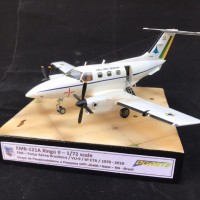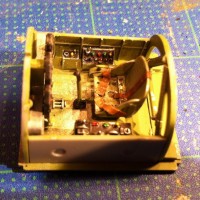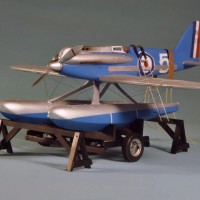Two become one, one becomes two: a strange modelling story about an even stranger flying vehicle,: A-90 "Orlyonok" Ekranoplan, part I
The mysterious aircraft presented here is surprisingly difficult to categorise. Although it flies at a speed of several hundred kilometres per hour and is reminiscent of a classic aeroplane in many parts, it also moves with a spray or dust swirling drama over a wide variety of surfaces in a way that only a hovercraft could - which it clearly is not. If, on the other hand, you see it at sea at slow speed, the comparison with a ship comes to mind. But this would also be wrong.
The speed ranges in which this ship-sized colossus travels also do not help in arriving at an interpretation, but rather increase the astonishment: the enormous, 60 metre long construction speeds over a wide variety of surfaces at an incredible 400 km/h, but can also slow down to a standstill, so that the 140 tonnes of dead weight finally sink into the water with a tremendous roar or come to rest on land on a seemingly strangely small landing frame. The categories of aeroplane, ship or hovercraft don't get you very far with this mysterious monster, but there is of course a technical category for which all the phenomena described are typical!
The knowledgeable reader will already know at this point that the A.90 "Orlyonok" is a so-called ground effect vehicle. This is an amazing class of vessel which, to put it bluntly, combines the advantages of different worlds. Large and voluminous like a ship, fast like an aeroplane and largely independent of the nature of the ground like a hovercraft! The underlying drive principle is an air cushion on which the hull rides over the waves. This is generated during the journey by the shape of the fuselage floor and the wings, which are flush with the two side nacelles. The two powerful turbines at the front of the fuselage not only provide propulsion: directed slightly downwards and thus into the cavity formed by the fuselage and wings, their exhaust jet ensures the formation of the air cushion when travelling slowly. Whether the ground is wet, dry or semi-solid is irrelevant, but a reasonably level surface is a prerequisite for the efficiency of the air cushion.
However, the A.90 has no problem finding this during its planned missions: the "Orlyonok" was designed in the early 1970s for use as a fast combat zone transporter for amphibious landing operations. This also explains the remarkable ring of joints around the front fuselage area: the entire nose section could be swivelled 90 degrees to one side within minutes in order to unload an impressive 20 tonnes of military payload using on-board ramps. This could also include heavy equipment such as a BTR-60PB infantry tank weighing around 10 tonnes.
Since the end of the 1960s, the USSR had been researching the development of ground effect vehicles, the development of which was entrusted to the "Central Design Bureau for Hydrofoils" under the direction of Rostislav Alexeyev. The first flight of the A.90 took place in autumn 1972 on the Volga, for further testing and also its use it was moved to the coasts of the Caspian Sea. A total of five examples were built, two of which were lost in accidents during their service life, while the remaining three were only decommissioned in 1993. Two of these impressive giants - the prototype S-23 and the S-26 - have been preserved as museum ships. However, the S-21 (MDE-150) shown here with the distinctive emblem on the hull capsized in a storm on 3 November 1979.
Incidentally, the Russian word "Orlyonok" means "young eagle", which explains the large-format depiction on the flanks of the A.90 /S-21. However, one could assume that a "young eagle" might also have a parent animal - and indeed, the A.90 was not the only ekranoplan being researched in the Soviet Union at the time and which was actually being trialled in small numbers! While the A.90 was designed as an amphibious landing transport, the vehicles of the "Lun" class brought a ground effect vehicle to operational readiness that was equipped to engage enemy ship formations. While the A.90 could still claim a certain formal elegance, the representatives of the over 70 metre long "Lun" class were more impressive due to their monstrous shape, which made them appear even more like a hybrid between ship, aircraft and, well, a product from the science fiction universe. They were to become known as "Caspian sea monsters" for good reason!
About the kit and the building process
Before I explain why I want to cover two articles with this one model, a short story about how a nuisance can become something good: the reason for the realisation of this "Orlyonok" was a build commission. As I liked the theme, I planned to build a second model for myself at the same time. As these kits - both the originals from Zvezda and the Revell editions - are currently hard to find, I was very happy to be able to get my hands on a second kit through an inheritance sale. However, the joy was soon followed by the realisation that the kit I had just acquired was unfortunately incomplete: a lot of parts - about a whole half of the fuselage - were missing.
Thinking about how to make the best of this situation, I decided to present the impressive A.90 "Orlyonok" as impressively as possible twice with the one realisable model! On the one hand, the finished model was to be shown standing on its own undercarriage, and on the other, I would use individual components from the second kit to display the Ekranoplan flying. The plan was to modify the model so that the new owner could switch between the two states at any time.
A description of how I did this and how the construction went will soon be available in a second part of this model project!


















Very cool!
Awesome! Love the over-water display.
This is definitely a remarkable aircraft, Roland @rosachsenhofer
Both dioramas are great but the hovering display is really outstanding.
Wow! 😁 The imagination of the designers of this aircraft is only exceeded by the skill and creativity on display here, Roland @rosachsenhofer! Fantastic work, sir! 👏
Man, what a story and what a model! 🤩
Awesome job as always, Roland!
Another outstanding product of RO Sachsenhofer Flugzugbau AG!
That diorama is the absolute BOMB. Wow!
Thank you very much for these motivational boosts in the form of your interested, friendly and frequent responses! These are of course very much appreciated and also make me a little proud 🙂
Now you need to find a THIRD kit, then make a beach diorama with the front end folded open, and tanks disgorging from the cavernous interior! That would be epic, for sure.
Congratulations, Roland, on another magnificent model.
Thanks Marvin for your comment and suggestion! Well, I could do it all with the one existing model: a few magnets here and there and some fretwork - three in one! 🙂